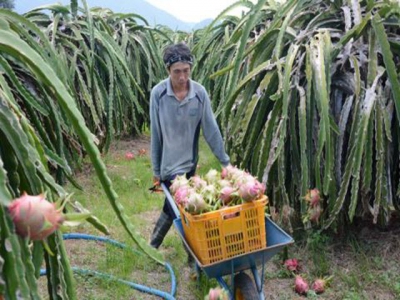Vietnamese dragon fruit farmers worried as Chinese market shrinks

China has been expanding the growing area of many kinds of farm produce and has gradually reduced imports from Vietnam.
The dragon fruit price is decreasing
The dramatic price fall of dragon fruit has been hot news recently.
The problem, as analysts say, lies in the heavy reliance on China with 80-90 percent of output exported to the market. Meanwhile, China has been expanding its dragon fruit growing area for many years.
According to the Ministry of Industry and Trade (MOIT), the dragon fruit growing area in China has reached 35,000 hectares, equal to Vietnam. The Chinese government also plans to increase the watermelon growing area by one percent per annum, or 2.2 million hectares, in 2015-2020.
Like Vietnam, China harvests dragon fruit in the months from May to November. The country not only grows watermelon but also in leased land in Laos, Cambodia and Myanmar.
The same is occurring with other farm produce. Nguyen Dinh Tung, general director of Vina T&T Group, said the litchi price dropped sharply last June because of abundant supply and low demand from China, where farmers also had a bountiful litchi crop.
MOIT informed farmers of the Chinese move of expanding dragon fruit growing areas. However, farmers still continued to expand the dragon fruit area, which is beyond the control of local authorities.
Vietnam’s bananas have also seen prices fall because of decreased sales to China, which now can satisfy its demand with domestic output. There are about 300,000 hectares of banana growing area in China, mostly in southern provinces.
Vietnam is the world’s second biggest coffee bean exporter, just after Brazil. Surprisingly, Vietnam’s coffee imports from other countries have been increasing significantly in recent years.
Nguyen Quang Binh, a coffee expert, said China has jumped to the 12th position in the world in coffee output. In recent years, the country began exporting coffee products, including to Vietnam.
MOIT informed farmers of the Chinese move of expanding dragon fruit growing areas. However, farmers still continued to expand the dragon fruit area, which is beyond the control of local authorities.
Tung from Vina T&T recalled that some years ago farmers rushed to cut down white-flesh fruit to grow red-flesh dragon fruit because the latter could be sold at higher prices.
However, as the red-flesh dragon fruit growing area expanded too rapidly, the price then tumbled dramatically and farmers suffered heavily from an oversupply.
Vo Mai, deputy chair of the Vietnam Gardeners’ Association, said that farmers do not have sufficient information about the Chinese market, even though this is an important market. This puts Vietnam’s farm produce at high risk.
Vo Tong Xuan, the leading agriculture expert in Vietnam, agrees that farmers just follow the crowd when organizing production, and do not have necessary information.
Related news
 An 8X guy started up with the model of clean food production
An 8X guy started up with the model of clean food production An 8X guy Bui Huy Chuong, 1984, in Minh Son village, Yen Tri commune (Yen Thuy) started to make his passion of producing clean food to provide for consumers.
 MARD promotes development of geographical indications and trademark of agricultural product
MARD promotes development of geographical indications and trademark of agricultural product MARD as requested specialized agencies to develop trademarks for major items, including: rice, coffee, Tra fish and shrimp, and develop geographical indications
 Policy obstacles hinder the development of agricultural land
Policy obstacles hinder the development of agricultural land Land is considered the most important aspect of agricultural production. However, slow land accumulation and policy obstacles are hindering the development